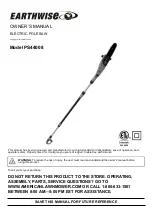
420 774 335 397 www.sharks-shop.cz Stránka 32
f) Blade depth and bevel adjusting locking levers must be tight and secure before making cut. If blade
adjustment shifts while cutting, it may cause binding and kickback.
g) Use extra caution when sawing into existing walls or other blind areas. The protruding blade may
cut objects that can cause kickback.
Lower guard function
a) Check lower guard for proper closing before each use. Do not operate the saw if lower guard does
not move freely and close instantly. Never clamp or tie the lower guard into the open position. If saw is
accidentally dropped, lower guard may be bent. Raise the lower guard with the retracting handle and
make sure it moves freely and does not touch the blade or any other part, in all angles and depths of
cut.
b) Check the operation of the lower guard spring. If the guard and the spring are not operating
properly, they must be serviced before use.
Lower guard may operate sluggishly due to damaged parts, gummy deposits,
or a build-up of debris.
c) Lower guard may be retracted manually only for special cuts such as "plunge cuts" and "compound
cuts". Raise lower guard by retracting handle and as soon as blade enters the material, the lower
guard must be released. For all other sawing, the lower guard should operate automatically.
d) Always observe that the lower guard is covering the blade before placing saw down on bench or
floor. An unprotected, coasting blade will cause the saw to walk backwards, cutting whatever is in its
path. Be aware of the time it takes for the blade to stop after switch is released.
Riving knife function
a) Use the appropriate saw blade for the riving knife. For the riving knife to function the body of the
blade must be thinner than the riving knife and the cutting width of the blade must be wider than the
thickness of the riving knife.
b) Adjust the riving knife as described in this instruction manual.
Incorrect spacing, positioning and alignment can make the riving knife ineffective in preventing
kickback.
c) Always use the riving knife except when plunge cutting. Riving knife must be replaced after plunge
cutting. Riving knife causes interference during plunge cutting and can create kickback.
d) For the riving knife to work, it must be engaged in the workpiece. The riving knife is ineffective in
preventing kickback during short cuts.
e) Do not operate the saw if riving knife is bent. Even a light interference can slow the closing rate of a
guard.
















































